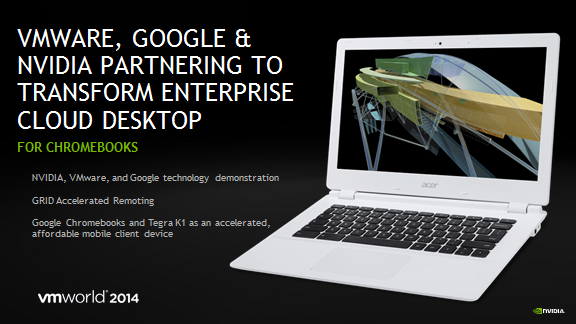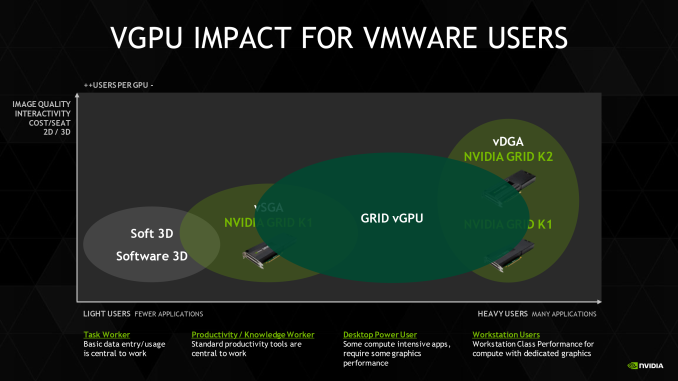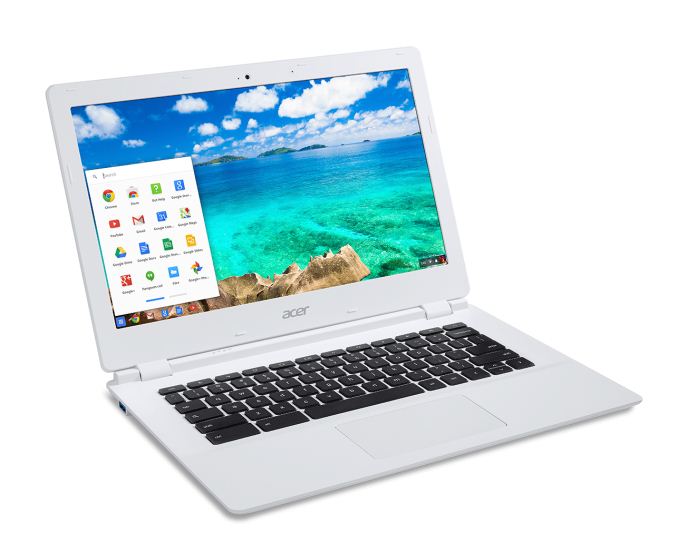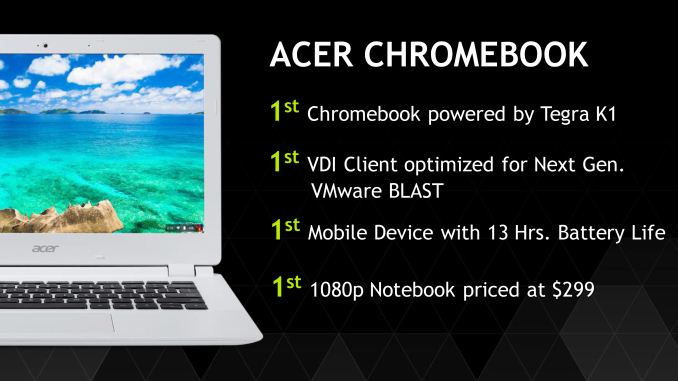NVIDIA & VMware Preview GRID vGPU & Tegra K1 Chromebook Support
by Ryan Smith on August 27, 2014 9:15 AM EST
NVIDIA has been anything but shy about their GPU virtualization aspirations, making it a focal point for the company’s development since the launch of their first GRID cards back in 2012. The company sees GPU virtualization as becoming increasingly important for enterprises – just as CPU virtualization has over the last decade – and in the last 2 years has been working on executing a plan on break into the GPU virtualization market. Their hardware was in many senses the easy part, and served to solve the chicken and egg problem that many technologies face. The hard part? Bringing up the software ecosystem to make use of this hardware.
Which is why the company is particularly excited about this year’s VMworld conference, VMWare’s annual virtualization technical conference. After seeding the market with hardware and spending their time working with major virtualization software developers such as VMWare and Citrix, NVIDIA’s efforts are finally coming to fruition as these products integrate support in their hypervisors for the GPU virtualization mechanisms required to make the most of NVIDIA’s hardware. To that end NVIDIA and VMWare are announcing a pair of NVIDIA-centric developments from this year’s show.
First and foremost, GRID vGPU support on VMware’s vSphere product is nearing completion. With the final version expected to be launched next year, NVIDIA and VMware are now in the process of launching an early access program for existing users to begin end-user trials.
This program is targeted at existing GRID users who are already making use of VMWare’s more limited functionality vSGA and vDGA modes, which utilize graphics API wrappers or directly mapped (1:1) GPUs respectively. With vGPU support now up and running, clients can now experiment with time sharing the GPUs directly. This offers potentially much greater density than vDGA’s directly mapped GPUs, but is still going through real hardware and allowing full access to NVIDIA’s GPU drivers and features instead of the much more limited generic Direct3D 9ish feature set that vSGA offers. In NVIDIA’s world vGPU support doesn’t fully supplant either vSGA or vDGA, but it offers a middle ground between the high density of vSGA and the performance of vDGA, while also offering a higher density option that maintains full GPU access and functionality.
Meanwhile NVIDIA’s second announcement of the day is focused on the client side of the usage model, specifically when it comes to Chromebooks. As previously announced by Google and VMware, the firms have been working to bring VMware BLAST support to Chromebooks, and today NVIDIA is announcing that they will be the hardware launch partner for this project. The company’s Tegra K1 SoC will be the first Chromebook SoC to support BLAST, with NVIDIA leveraging K1’s hardware video decoder to decode the BLAST video stream.
Acer’s recently announced K1-powered Chromebook 13 devices will in turn be the first Chromebooks out the door with this functionality. With the Chromebook software stack already bordering on being a thin client environment, NVIDIA, Google, and VMware believe using Chromebooks as actual thin clients is a natural extension of the device’s functionality. Meanwhile Chromebooks’ mass-market appeal means that the cost of these devices kept low due to their high production volume, allowing for what amounts to a 13” 1080p thin client laptop to sell for under $300, a much lower price than previous thin client devices.
Ultimately for NVIDIA this furthers their own efforts in a twofold manner. By providing a strong economic incentive for virtualization this helps server hardware sales, but it also means NVIDIA gets a piece of the pie through client hardware sales. Meanwhile for VMware this furthers the reach of their own virtualization platforms, both figuratively and literally by getting more laptop-style thin clients on to the market.
Finally, as part of their keynote presentation, VMware has a short video from NVIDIA on the announcement, including a brief showcase of the Chromebook thin client in action.
Source: NVIDIA













11 Comments
View All Comments
TETRONG - Wednesday, August 27, 2014 - link
Hmm, a laptop that's half the price with 1/8 the GPU power.. nice dream but internet service is shit around the world..prices are going up and they're putting the squeeze on everyone.Think I'll just wait for Intel to integrate the Iris Pro+RAM into every chip they make..graphics are already stuttery/jittery enough without going through all this hassle.
Ktracho - Wednesday, August 27, 2014 - link
I don't think the target is the random customer who happens to be in a random place around the world. Rather, I think it makes sense for companies with hundreds of employees who may need to be somewhat mobile within a geographic region (such as their own offices) that has good network infrastructure.Personally, I think it would be cool to have a set up at home that allowed multiple family members to share a single, powerful computer. It may ultimately not be better than one or more devices per person (tablet, PC, etc.), but it would be less boring.
JMurph - Saturday, September 6, 2014 - link
The idea here is that the expensive laptop or desktop is eliminated, single points of failure eliminated, user interaction and helpdesk brought down to almost zero, and sharing of the expensive resources on an inexpensive vm on a server, with the "at risk" endpoint desktop costing about $300. This is no-brainer industry changing, paradigm-shifting stuff.shaw44 - Saturday, September 13, 2014 - link
I think he means that fact that it's mobile thus the ability to work from any local you desire, that is the future. A strong broadband infrastructure isn't in place and looks like it might not arrive anytime soon.MadEyeMoody - Wednesday, August 27, 2014 - link
The system does shave off the need to maintain expensive workstations in CAD/CAM design houses. It can potentially be useful even in Gaming industry (think of LanParties) or enterprise workloads that rely heavily on GPU muscle.ArthurG - Wednesday, August 27, 2014 - link
Very very smart move for Nvidia and Google to bring chromebooks in big corporates.twotwotwo - Wednesday, August 27, 2014 - link
Going to get that Chromebook and great remote desktop on it would be awesome; just wish it were available to Joe Schmoes like me, not only folks that have invested in all of that VMWare and NVidia kit.SpartyOn - Wednesday, August 27, 2014 - link
This technology needs to be available to consumers at the entry-level sooner rather than later. If Nvidia rolled this out tomorrow, I would sell every gaming desktop & laptop in my house and build a tri-SLI GTX 780 6GB (or whatever vGRID-enabled mainstream GPU would be out there), dual Xenon machine, with 32GB RAM and could then bury it in my basement out of the way. Then I could use Chromebooks/tablets/Nvidia Shield's as fully-capable connected machines.Basically one big, stationary gaming box that everyone could connect to while still being able to play their games at full speed with high-level graphic settings. I'd never buy another gaming laptop again and my desktop upgrade cycle would be lessened to only one machine (albeit a power hungry, expensive behemoth).
WatcherCK - Wednesday, August 27, 2014 - link
That sounds like a good setup, and how the big metal companies (Microsoft, Nvidia, Google, Vmware, AMD??) are positioning themselves in the big picture, pricing for the layman? That will be the monthly subscription geolocked question of the decade :). Ive been wanting to setup a machine similar to what you describe, but more along the lines of what is capable now, one use of which would be to run a steam server on a Windows VM Client that uses a VT-d on a Proxmox host for example, at this stage though there is alot of work to just find compatible gear much less get everything up and running, one day though right?Davey Jones' Locker - Friday, August 29, 2014 - link
So this can run Windows?